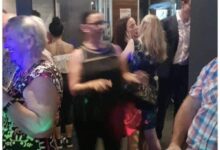Elijah McClain Video: Important evidence in court

The “Elijah McClain Video“ has emerged as a key piece of evidence in a tragic and transformative chapter of American policy and social justice. This video captures the heartbreaking encounter between Elijah McClain, 23, a gentle and introverted black man, and police officers in Aurora, Colorado, in 2019. Join batdongsancafef.vn Discover the details of the video of the incident.
I. Who is Elijah McClain?
Elijah McClain is a 23-year-old black man whose name was tragically made famous by a deadly encounter with police officers in 2019. The case has attracted widespread attention. widespread attention, especially after the release of the “Elijah McClain Video”. the events that led to his untimely death.
Elijah McClain’s Background: Elijah McClain is a resident of Aurora, Colorado, known for his gentle and introverted nature. He worked as a massage therapist and was described by family and friends as a compassionate person.

Fateful meeting: On the night of his encounter with law enforcement, Elijah McClain was walking home from a convenience store. He wore a runner’s mask that covered his face under his eyes because he was anemic, making him susceptible to colds. Police were responding to a report of a “sketchy” person in the neighborhood who initiated the interaction.
II. Elijah McClain Video
The key to understanding the events surrounding Elijah McClain’s death is police body camera footage. This “Elijah McClain Video” has helped shed light on the circumstances leading to his death.
Escalation of the encounter: The video shows how quickly the encounter escalated as officers took McClain to the ground.
Use of force: The video depicts an officer using his hand to hold McClain’s neck, pressing on McClain’s carotid artery. This resulted in McClain losing consciousness at least once during the encounter.
Medical Predicament: Elijah McClain can be seen vomiting repeatedly after the neck restraint is applied and he remains on the ground for an extended period of time.
Ketamine Administration: Paramedics injected 500 milligrams of ketamine into McClain and he went into cardiac arrest while being transported to the hospital. Sadly, three days later, he was taken off life support and did not survive.
The “Elijah McClain video” served as key evidence in the subsequent proceedings against the officers involved. It has sparked public outrage, renewed discussions about police use of excessive force and contributed to a wider debate about racism within the police force. in the United States.

III. Evidence and Evidence in the Video
1. Elijah McClain’s Agony:
The “Elijah McClain Video” vividly captures the distress and agony experienced by Elijah McClain during the encounter with the police officers. Key points regarding his suffering include:
– Audible Distress: Throughout the video, viewers can hear McClain audibly expressing distress and discomfort. He can be heard crying out in pain and pleading with the officers, indicating that he was in significant distress.
– Physical Struggle: The video shows Elijah McClain physically struggling while being restrained by the officers. His body language and movements reflect his discomfort and pain as he attempts to resist the hold placed on him.
– Vomiting: The video documents McClain vomiting multiple times after being subjected to a neck hold. This not only highlights his physical distress but also suggests the severity of the force used against him.
2. The Reaction of the Police Officers in the Video:
The video also captures the responses and actions of the police officers involved in the incident. Notable aspects of the officers’ behavior in the video include:
– Use of Force: The video provides a clear visual record of the force employed by the officers, including the application of a neck hold on Elijah McClain. This visual evidence allows for an objective assessment of the level of force used during the encounter.
– Verbal Interaction: The video includes verbal exchanges between McClain and the officers. Viewers can observe the tone and language used by both parties, which may provide insights into the dynamics of the interaction.
– Duration of Restraint: The video documents the duration for which Elijah McClain was held down by the officers. This duration is critical in assessing whether the use of force was excessive or prolonged.
3. The Change in McClain’s Health Condition in the Video:
Elijah McClain’s health condition deteriorates noticeably throughout the course of the video. Key points related to this deterioration include:
– Loss of Consciousness: The video captures moments when McClain loses consciousness after the neck hold is applied. These instances are significant in understanding the impact of the hold on his well-being.
– Struggles to Breathe: As the video progresses, McClain’s breathing becomes more labored. Viewers can observe changes in his respiratory distress, which is a crucial indicator of his deteriorating health.

– Administration of Ketamine: Towards the end of the video, paramedics arrive and administer 500 milligrams of ketamine to McClain. This intervention, captured in the footage, is part of the narrative of his declining health.
The “Elijah McClain Video” serves as a critical piece of evidence that documents the physical and emotional aspects of the encounter. It provides a visual record of both McClain’s suffering and the actions of the police officers, enabling a comprehensive assessment of the events leading to his tragic death. This evidence has played a central role in the legal proceedings and public discourse surrounding the case.
IV. Aftermath of the Elijah McClain Video
1. The Advancement of Video in Investigations and Litigation:
The release of the “Elijah McClain Video” had significant implications for investigations and litigation related to the case. Key points regarding the advancement of video evidence include:
– Legal Accountability: The video became a central piece of evidence in the criminal proceedings against the police officers involved. It provided a clear and irrefutable record of the events, allowing lawyers, judges, and jurors to assess the actions of the officers accurately.
– Independent Review: The video enabled independent investigators and legal experts to scrutinize the incident. It facilitated a comprehensive analysis of the use of force, which was crucial in determining whether charges should be filed against the officers.
– Public Oversight: The video contributed to increased public oversight of the case. It allowed concerned citizens and advocacy groups to closely examine the actions of law enforcement, advocating for transparency and accountability in the justice system.
2. The Reaction of the Public and Community After Watching the Video:
The release of the video had a profound impact on the public and the community, sparking a range of reactions and responses:
– Outrage and Protests: Many members of the public expressed outrage after witnessing the events in the video. The graphic nature of the footage and McClain’s evident suffering led to protests and calls for justice in Aurora and beyond.
– Community Mobilization: The video galvanized community activists and organizations to demand accountability and police reform. It prompted discussions about racial bias in policing and the need for systemic changes.
– Support for McClain’s Family: The video garnered sympathy and support for Elijah McClain’s family, who had long been seeking answers and justice for their loved one. It brought their plight into the national spotlight.
3. Changes in Law or Politics After the Video Was Released:
The “Elijah McClain Video” played a role in shaping both legal and political developments:
– Legal Reforms: The case prompted discussions about the use of ketamine by paramedics and the need for stricter guidelines. In some jurisdictions, it led to policy changes regarding the administration of sedatives in similar situations.
– Political Initiatives: The video influenced political discourse and prompted elected officials to take action. It led to calls for legislative changes related to police accountability, use of force, and transparency.
– Ongoing Conversations: The release of the video initiated ongoing conversations at the local, state, and national levels about the role of video evidence in police accountability, as well as the broader issues of racial justice and policing practices.
In summary, the “Elijah McClain Video” not only had immediate legal implications but also triggered a wave of public activism, community engagement, and discussions about the need for reforms in law enforcement and the justice system. It underscored the potent role that video evidence can play in bringing about change and accountability in cases of alleged police misconduct.
V. Elijah McClain Video Impacts Media
1. Media and Public Attention to the Case:
The release of the “Elijah McClain Video” had a profound impact on media coverage and public attention to the case. Key points regarding media attention include:
– National Spotlight: The video catapulted the Elijah McClain case into the national spotlight. Major news outlets across the United States and beyond extensively covered the incident, highlighting the significance of the video evidence.
– Prolonged Coverage: Media outlets continued to report on the case over an extended period, from the initial release of the video through subsequent legal developments, protests, and calls for justice.
– Investigative Journalism: Journalists conducted investigative reporting to provide context and background on the case, exploring issues such as racial discrimination in policing, the use of ketamine, and police accountability.
2. Social Media Interactions and Video Virality:
The “Elijah McClain Video” had a significant presence on social media platforms, and its virality played a crucial role in shaping public discourse:
– Viral Spread: The video quickly went viral on platforms like Twitter, Facebook, and Instagram. Viewers shared and commented on the video, amplifying its reach and sparking conversations about the incident.
– Hashtag Movements: Social media users created hashtags related to the case, such as #JusticeForElijahMcClain and #ElijahMcClain. These hashtags became rallying points for activists and supporters.
– Amplifying Voices: Social media allowed individuals and communities to amplify their voices, share their perspectives, and demand justice. It also facilitated the organization of protests and events in support of Elijah McClain.
3. How the Video Contributed to the Discussion About the Scope of Police Use of Force:
The “Elijah McClain Video” significantly contributed to the broader conversation about the scope of police use of force and related issues:
– Evidence of Excessive Force: The graphic nature of the video provided a clear example of what many perceived as excessive force by law enforcement. It prompted discussions about the appropriate use of force in encounters with citizens.
– Calls for Reform: The video became a focal point in discussions about police reform, leading to calls for changes in training, policies, and oversight to prevent similar incidents.
– Public Scrutiny: The widespread dissemination of the video led to increased public scrutiny of police practices. It underscored the importance of transparency and accountability in law enforcement.
– Influence on Legislation: Policymakers cited the video as a motivating factor for introducing and passing legislation aimed at addressing issues related to police misconduct, use of force, and body cameras.
In summary, the “Elijah McClain Video” had a far-reaching impact on media coverage, social media engagement, and the larger conversation about police use of force. It galvanized public awareness, fueled activism, and contributed to efforts to reform policing practices and ensure greater accountability within law enforcement agencies.
VI. Importance and Lessons Learned from the Elijah McClain Video
The “Elijah McClain Video” holds immense importance, not only as evidence in a specific case but also as a catalyst for broader discussions and lessons that society can draw from this tragic incident:
1. Importance of the Elijah McClain Video:
Transparency and Accountability: The video exemplifies the importance of transparency in law enforcement. It offers an unfiltered view of a critical incident, allowing for a thorough examination of the actions of both police officers and the victim.
Amplifying Voices: The video served as a platform for Elijah McClain’s voice, allowing the world to witness his suffering. It brought attention to the experiences of marginalized communities who often face unjust treatment at the hands of law enforcement.
Legal Proceedings: In the legal context, the video played a central role in holding the involved officers accountable for their actions. It became a critical piece of evidence in the ongoing investigation and trial.
Public Awareness: The video heightened public awareness about issues related to police brutality, racial bias, and excessive use of force. It galvanized public support for justice and reform.
2. Lessons Learned from the Elijah McClain Video:
The Power of Video Evidence: The case underscores the power of video evidence in documenting and exposing incidents of alleged police misconduct. It highlights the need for widespread use of body cameras and dashcams to enhance transparency and accountability.
Racial Bias and Policing: Elijah McClain’s case shed light on racial bias in policing. It prompts discussions about the disproportionate impact of such biases on communities of color and the urgency of addressing systemic racism within law enforcement.
Use of Force Guidelines: The video raised questions about the appropriateness and proportionality of the use of force by police officers. It emphasizes the importance of revisiting and refining use of force guidelines and training.
Paramedic Practices: The administration of ketamine highlighted the need for oversight and standardization of paramedic practices, especially when sedatives are involved. The incident spurred discussions about improving protocols for medical interventions in law enforcement encounters.
Community Mobilization: Elijah McClain’s case demonstrates the power of community mobilization, grassroots activism, and social media in advocating for justice. It underscores the importance of collective action in pushing for change.
Political Engagement: The case illustrates how public pressure can lead to political engagement and policy reforms. It serves as a reminder that citizens have the ability to influence legislative changes.
In conclusion, the “Elijah McClain Video” has had a lasting impact on the way society views police accountability, racial bias, and the use of force. It emphasizes the need for continued efforts to address systemic issues within law enforcement, promote transparency, and strive for justice. The lessons learned from this tragic incident can inform future reforms and initiatives aimed at creating a more equitable and just society.









